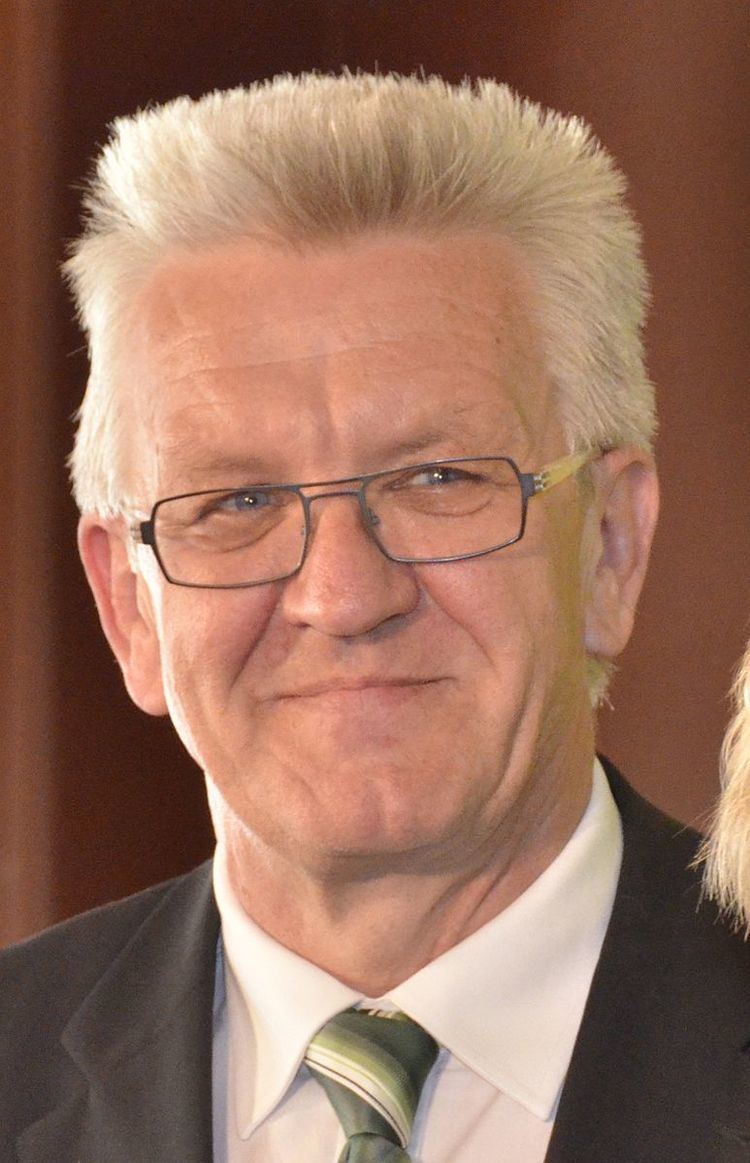13 March 2016 (2016-03-13) 2021 → 60 seats, 39.0% Did not contest 60 0 | 36 seats, 24.1% 60 seats, 39.0% 36 60 47 42 | |
 | ||
The Baden-Württemberg state election 2016 was held on 13 March 2016 to elect members to Baden-Württemberg's State diet, the Landtag of Baden-Württemberg in Stuttgart. It was the 15th state election since the foundation of Baden-Württemberg in 1952. Going into the election, Winfried Kretschmann of Alliance '90/The Greens led a coalition government of his party with the Social Democrats. After the election, Kretschman was confirmed in May 2016 leading a coalition with the CDU, the first time the Greens have led such a coalition in Germany.
Contents
Like in all German states, elections in Baden-Württemberg follow the mixed member proportional representation. There are 70 constituency seats and at least 50 additional seats to be filled, making up a total of seats of at least 120. A higher number can be reached through overhang seats and additional seats to restore proportional representation. Unlike all other states, there are no party lists. Instead, the seats for a party which are not filled by constituency winners go to the party's remaining constituency candidates with the highest percentages of votes. The Sainte-Laguë method is used to calculate the seat allocation.
Campaign and issues
The Greens campaigned to keep Minister-President Winfried Kretschmann in office. Their central issues were energy, economics, and education. The CDU aimed to put an end to the green-red state government and usher in its own leading candidate Guido Wolf to head the state government. Themes in focus for the CDU were education policy, internal security, and the issue of infrastructure, including high-speed internet. The SPD, led by Nils Schmid, wanted to win more votes to continue the existing government coalition with The Greens. The SPD's campaign mainly focussed on "good jobs", educational equality, and more time for the family. The electoral goal of the FDP, led by Hans-Ulrich Rülke, was to repeat its entry into the state parliament and possibly be involved in a governing coalition. They promised better education, the strengthening of the local business, and improvement of mobility. The AfD party campaigned to be elected into the state parliament for the first time. Its leading candidate Jörg Meuthen saw migration policy as an important election issue, alongside education, security, and energy transition.
The election campaign was overshadowed by the European migrant crisis. In the crisis, Kretschmann supported the policies of Chancellor Angela Merkel. Kretschmann said he saw no other person who could keep Europe together as Angela Merkel did. "Therefore, I pray every day that the Chancellor remains healthy." CDU candidate Wolf also emphasized support for Merkel's "European solution" in the crisis, but in February 2016 tried to win more conservative voters by a joint proposal along with Rhineland-Palatinate CDU candidate Julia Klöckner for daily refugee quotas and border centers for migrants, which put additional pressure on Merkel.
Polls
The reference for the polls is wahlrecht.de.
Aftermath
In the prior election of 2011, the Green/SPD coalition obtained a majority (73 of 138) votes in the Landtag, including two opposition votes; however after the 2016 vote, the coalition fell short of a majority, with a combined total of 66 seats (72 needed for a majority). Kretschmann's popularity propelled the Green Party to a gain of 11 seats, making history as the first time the Green party has been the largest party in State-level election results. However, the Greens' coalition partner, the SPD, lost 16 seats, thus depriving the Greens' of a clear majority of leftists.
There were several possible and probable working majorities among the five parties in the Landtag. Expanding the existing coalition into a three-party "traffic light" coalition (green-red-yellow) by including the FDP would have given the administration a working majority of 6. Coalitions with AfD appeared unlikely: a CDU-AfD coalition would be 7 short of a majority in the Landtag, so would have also needed to include the FDP to make a majority and remove Kretschmann as minister-president. Removal of Kretschmann was unlikely; CDU leader Guido Wolf briefly sought to get the Social Democrats into a right-of-centre coalition with the FDP (with Wolf as state minister-president), but his SPD counterpart Nils Schmid pointed out that such a coalition would frustrate voters due to the personal popularity of Kretschmann. If it were possible to elect the minister-president directly, Kretschmann would have won an outright majority according to polls; he was even favored by 45% of CDU supporters.
In May 2016, the Landtag confirmed Kretschmann's leadership in a secret ballot. He won 82 votes leading a "green-black" coalition with a nominal majority of 89 Landestag members (Green 47, CDU 42). A similar "black-green" coalition headed by the CDU has governed in Hesse since the similarly indecisive 2013 elections, but this is the first time the Green Party is the lead coalition partner. Kretschmann formed the Cabinet Kretschmann II as the state government.
